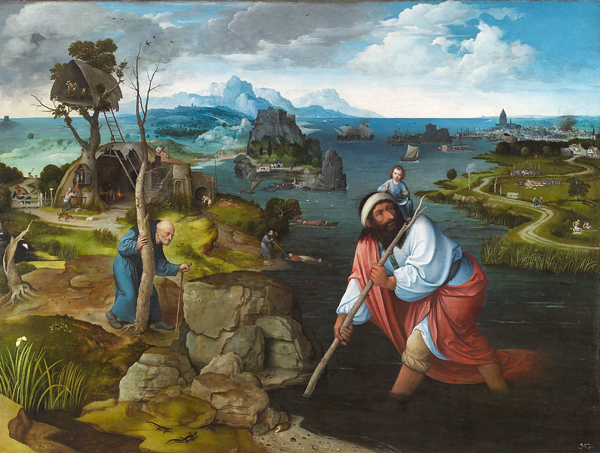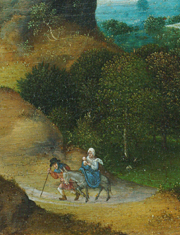Flemish painter Patinir, active at the beginning of the XVIth century, is considered the forerunner of landscape painting. The Prado owns a very rich collection of Flemish painting. Through this retrospective it will help shed some light on this artist who still remains mysterious. Out of the forty-eight paintings shown, twenty-two are by Patinir himself, while the rest are from his most important precursors or disciples. We are given the opportunity to discover unique compositions that never cease to surprise us by the marriage between fiction and reality, as well as by the lyrical reference to the grandeur of Nature.
Antwerp, the capital of the arts
The exhibition at the Prado museum is the first dedicated to painter Joachim Patinir, a Flemish artist from the XVIth century. A contemporary of Jerome Bosch, he was probably born between 1480 and 1485 in the South East of what is currently Belgium. It is believed he worked as a painter in Antwerp in 1515 and that he died in 1524. Dürer described him as that “good painter of landscapes”, and Patinir is considered as the first of the modern era to have specialized in that genre. Naturally, the geographic factor plays an important role in the birth of landscape painting. Antwerp was of course the heart of the European art market and its huge production, more profane than elsewhere, was controlled by the artists themselves rather than by the Church.
Three fourths of Patinir's works are brought together
The exhibition presents 22 of the 29 paintings attributed to Patinir by the commissioner, Alejandro Vergara, the chief curator for Flemish painting at the Prado museum. It also includes 27 paintings and works on paper by his predecessors and admirers, such as Jerome Bosch, Robert Campin or Dirk Bouts, in which the interest for the natural environment is increasingly manifest. The three rooms dedicated to Patinir show the originality of his style but are also concerned with the problem of attributing works of art. These works dated back to a time when it was common to work in workshops. It is not easy to make the difference between the master's hand and that of his assistants. There are also two pieces from private collections, recently attributed to Patinir and his workshop, the Triptych with Saint Jerome in penitence and Landscape with a crucifix.
Skill comes with maturity
The progressive skill Patinir acquired in painting landscapes is dazzling in his last, large dimensional works. Three of them are the core of the retrospective: Landscape with Saint Christopher from the Escorial Palace, Charon crossing the Styx and The temptation of Saint Anthony, the last two from the Prado. The exhibition brings together essential works such as the Martyrdom of Saint Catherine and the Baptism of Christ, from the Kunsthistorisches Museum in Vienna, the triptych Penitence of Saint Jerome, from the Metropolitant Museum in New York and the small but very magnificent Flight into Egypt from the Koninklijk Museum in Antwerp. The exhibition concludes by revealing the fundamental impact Patinir had on his contemporaries, such as Quentin Metsys (1466-1530), Bernard van Orley (towards 1488-1541), Joos van Cleve (died in 1540/1541), and on the artists of future generations such as Herri Met de Bles (died after 1550) and Jan van Amstel (died towards 1542).
Wealth of the Spanish collections
This is the largest retrospective ever dedicated to Patinir. Indeed, the majority of his works very rarely leave their lieu of conservation due to the specific problems inherent to oils on wood. Among the ones exposed, six belong to the Spanish collections (four to the Prado museum, the wealthiest in the world in this genre, that have recently been restored, one form the Thyssen and one from the monastery of San Lorenzo at the Escorial). We must note the important presence of Patinir's work in Spain, as nearly one fourth of his work is located in the area of Madrid. Deep research preceded the exhibition, carried out by the curators from the museums that host Patinir's works (such as the National Gallery in London or the Louvre). This culminated in the publication of Patinir's catalogue raisonné.
PUBLICATIONS
The exhibition is accompanied by the publication of a catalogue raisonné in which, aside from the twenty-two works shown, we can admire eight paintings by the Flemish artist, included in his production following the task successfully carried out to prepare the exhibition.
The museum also publishes a guide to the exhibition including an article from the curator “Patinir and the origin of landscape painting”, as well as illustrations of the works shown.
illutration JOACHIM PATINIR Landscape with the Flight into Egypt, detail Oil on panel, 18.3 x 22.4 cm c. 1516-1517 Antwerp, Koninklijk Museum voor Schone Kunsten
To see more illustrations, click on VERSION FRANCAISE at the top of this page
| 








